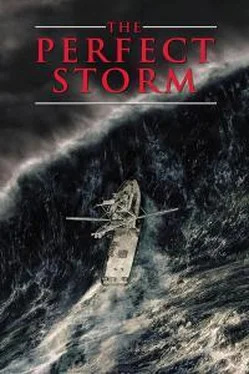Sebastian Junger - The Perfect Storm
Здесь есть возможность читать онлайн «Sebastian Junger - The Perfect Storm» — ознакомительный отрывок электронной книги совершенно бесплатно, а после прочтения отрывка купить полную версию. В некоторых случаях можно слушать аудио, скачать через торрент в формате fb2 и присутствует краткое содержание. Жанр: Триллер, Проза. Описание произведения, (предисловие) а так же отзывы посетителей доступны на портале библиотеки ЛибКат.
- Название:The Perfect Storm
- Автор:
- Жанр:
- Год:неизвестен
- ISBN:нет данных
- Рейтинг книги:3 / 5. Голосов: 1
-
Избранное:Добавить в избранное
- Отзывы:
-
Ваша оценка:
- 60
- 1
- 2
- 3
- 4
- 5
The Perfect Storm: краткое содержание, описание и аннотация
Предлагаем к чтению аннотацию, описание, краткое содержание или предисловие (зависит от того, что написал сам автор книги «The Perfect Storm»). Если вы не нашли необходимую информацию о книге — напишите в комментариях, мы постараемся отыскать её.
The Perfect Storm — читать онлайн ознакомительный отрывок
Ниже представлен текст книги, разбитый по страницам. Система сохранения места последней прочитанной страницы, позволяет с удобством читать онлайн бесплатно книгу «The Perfect Storm», без необходимости каждый раз заново искать на чём Вы остановились. Поставьте закладку, и сможете в любой момент перейти на страницу, на которой закончили чтение.
Интервал:
Закладка:
They're dead in the water, taking the huge waves broadside. According to Reeves, they are doing 360-degree barrel rolls and coming back up. Four boats try to respond to her mayday, but three of them have to stand down because of the weather. They cannot continue without risking their own lives. The oceangoing tug Triumph C leaves Sable Island and claws her way southward, and the Coast Guard cutter Edward Cornwallis is on her way from Halifax. The crew of the Eishin Maru, impassive, are sure they're going to die. Reeves is too busy to think about it; she has to look for the life jackets, work the radio and satellite phone, flip through the Japanese phrase book. Eventually she has a moment to consider her options.
"Either I jump ship, or I go down with the ship. As for the first possibility, I thought about it for a while until I realized that they'd hammered all the hatches down. I thought, 'God, I'll never get off this friggin' boat, it will be my tomb.' So I figured I'd do whatever I had to do at the time, and there was no point in really thinking about it because it was just too frightening. I was just gripped by this feeling that I was going to have to do something very unpleasant. You know, like drowning is not going to be pleasant. And it wasn't until the moment we lost steerage that I actually thought we were going to die. I mean, I knew there was a real possibility, and I was going to have to face that."
Soon after losing steerage, a communications officer in New York asks Reeves how it's going. Not too well, she says. Is your survival suit out? Yeah, it's here, she says. Well, how many Japanese can you fit into it? Reeves laughs; even that slight joke is enough to ease the desperateness of the situation. A couple of hours later the satellite phone rings. Improbably, it's a Canadian radio reporter who wants to interview her. His name is Rick Howe.
Miss Reeves, is it rough out there? Howe asks, over the static and wind-shriek.
It's pretty rough.
What about the trawler, what's the problem?
It's not a trawler, it's a longliner. The problem is we took three windows out of the bridge earlier this morning and lost all our instrumentation.
Are you in any danger or are you confident everything's going to work out all right?
Well, we're in danger, definitely we're in danger. We're drifting in twelve meter swells and between fifty and sixty knot winds. If we get any more water coming through the bridge that's gonna wipe out any communication that we have left. So we're definitely in danger right now.
Do you know how dose the nearest ship to you is?
We're looking at about a hundred miles. If we have to abandon ship there are helicopters that can be here in three-and-a-half hours. Unfortunately they won't be able to come in the dark, so if anything happens in the dark, we're goners.
You mentioned that you expect the weather to clear up later in the day. What more can you tell us about that?
The swell size is supposed to go down to five to eight meters and the winds come around to the east, twenty-five to thirty-five knots. So that will take a lot of the edge off the fear I have right now, which is of sustaining a direct hit. If we take a direct hit, and the boat goes over, and we take another hit, the boat goes down. And we're all shored up here, everything is battened down, hatched and practically nailed shut. If she goes over there's no way anybody's gonna get out, over.
Now is there a point where you may have to abandon ship, and is the crew and yourself prepared for that eventuality?
Well, to tell you the absolute truth I don't think the crew is very prepared for an emergency. They have no emergency beacon and don't seem very up on their emergency procedure, which is a little frightening. I'm the only one who has a survival suit. But, in a swell like we have today, it wouldn't do me much good.
Yeah, right. Well, listen, I thank you for talking to us, and the whole of the province is praying for your safe return.
Thank you.
With that, Reeves turns back to the business at hand.
AFTER talking to Tommy Barrie, Billy is probably able to steam northwest another two or three hours before the seas get too rough to take on his stern. That would place him just north of data buoy #44139 and on the edge of Banquereau, one of the old fishing grounds off Nova Scotia. The 200-fathom line turns a corner at Banquereau, running north up the St. Lawrence Channel and south-southwest to Sable Island. About sixty miles due east is an underwater canyon called "The Gully,” and then the Sable Island shallows start.
Sable Island is a twenty-mile sandbar that extends another forty or fifty miles east-west below water. From a distance, the surf that breaks on the shoals looks like a white sand cliff. Mariners have headed for it in storms, thinking they might save themselves by driving their boat onto the beach, only to be pounded to pieces by twenty-foot waves on the outer bar. Sable Island historian George Patterson writes, in 1894: "From the east end a bar stretches northeasterly for seventeen miles, of which the first four are dry in fine weather, the next nine covered with heavy breakers and the last four with a heavy cross-sea. The island and its bar present a continuous line of upwards of fifty miles of terrific breakers. The currents around the island are terribly conflicting and uncertain, sometimes passing around the whole circuit of the compass in twenty-four hours. An empty cask will be carried round and round the island, making the circuit several times, and the same is the case with bodies from wrecks."
The island prowls restlessly around the Scotian Shelf, losing sand from one end, building it up on the other, endlessly, throughout the centuries. Since 1873 it has melted away beneath the foundations of six lighthouses. Herds of wild horses live on the island, the descendants of tough Breton mountain horses left there by the French. Nothing but mar-ran grass holds the dunes in place, and cranberries, blueberries, and wild roses grow in the inland bogs. The Gulf Stream and the glacial Labrador Current converge at Sable, frequently smothering the island in fog. Five thousand men are said to have drowned in its shallows, earning it the name "The Graveyard of the Atlantic,” and at least that many have been pulled to safety by lifesaving crews that have been maintained there since 1801. "We have had a tolerable winter, and no wrecks, except the hull of the schooner Juno, of Plymouth," one island-keeper recorded in 1820. "She came ashore without masts, sails or rigging of any description, and no person on board except one dead man in the hold."
In bad weather, horsemen circled the island looking for ships in distress. If any were spotted, the horsemen rushed back for the surf boat and rowed out through the breakers to save anyone who was still alive. Sometimes they were able to fire rockets with a line attached and rig up a breeches buoy. After the storm died down they'd salvage the cargo and saw the ship timber up for firewood or construction material. People pulled from sinking ships often spent the entire winter on the island. Sometimes two or three hundred people would be camped out in the dunes, waiting for a relief ship to arrive in the spring.
Today there are two lighthouses, a Coast Guard station, a meteorological station, and several dozen oil and natural gas wells. There's a sixty-foot shoal thirty miles to the northwest and a forty-five-foot shoal twenty miles to the east. They mark the western and eastern ends of the sandbar, respectively. Billy isn't right on top of the bars yet, but he's getting close. In the old days it was known that most shipwrecks on Sable occurred because of errors in navigation; the westerly current was so strong that it could throw boats off by sixty to a hundred miles. If Billy has lost his electronics—his GPS, radar, and loran— he's effectively back in the old days. He'd have a chart of the Grand Banks on the chart table and would be estimating his position based on compass heading, forward speed, and wind conditions. This is called dead reckoning. Maybe the currents and the storm winds push Billy farther west than he realizes, and he gets into the shallows around Sable. Maybe he has turned downsea on purpose to keep water out of the wheelhouse, or to save fuel. Or maybe their steering's gone and, like the Eishin Maru, they're just careening westward on the weather.
Читать дальшеИнтервал:
Закладка:
Похожие книги на «The Perfect Storm»
Представляем Вашему вниманию похожие книги на «The Perfect Storm» списком для выбора. Мы отобрали схожую по названию и смыслу литературу в надежде предоставить читателям больше вариантов отыскать новые, интересные, ещё непрочитанные произведения.
Обсуждение, отзывы о книге «The Perfect Storm» и просто собственные мнения читателей. Оставьте ваши комментарии, напишите, что Вы думаете о произведении, его смысле или главных героях. Укажите что конкретно понравилось, а что нет, и почему Вы так считаете.












